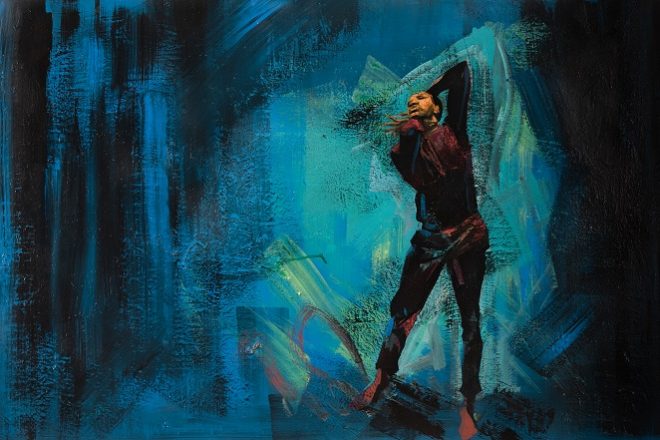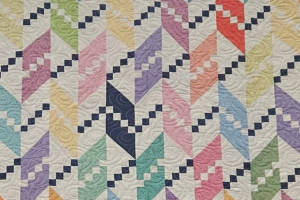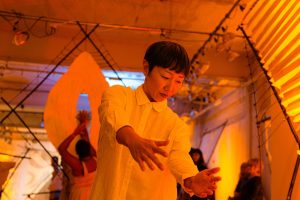ARTISTS WE LOVE: JOËLLE STORET

INTERVIEW / KODY FORD
IG / @JOELLEELLEOJ
ARTVENTURES-NWA.ORG/JOELLE-STORET
The work of Joëlle Storet is an amalgam of influences–comics like Tintin, her mother’s doodles, her African/European heritage and German Expressionism. It culminates in a style that is loose, whimsical, and vibrant. The Belgian-born Storet moved to the United States via Austria in 2001 where her family settled in Fayetteville. She took inspiration from a young age from Belgian comic books and the influence of one of the foremost novelists of the Congo in the 20th century, her grandfather Zamenga Batukezanga. She has since transmitted her Afro-European style and thematic expositions to the thriving artist community based in Northwest Arkansas. Storet graduated from the University of Arkansas with a background in Cultural Anthropology, Semiotics, Linguistics and Art History. Her bold palette and multifarious interests have allowed her to communicate her history through paintings, graphic designs, murals, and a whole host of other mediums. The emblematic connection/divergence between her African roots and her African American experiences is the thoroughfare on which she is currently exploring. She has had works exhibited in the United States, Vienna, Austria and Germany.
How would you describe your style currently?
I’ve been trying to evoke a style that emphasizes rigid forms that occupy a myriad of strange spaces. I’m very inspired by the space that I myself inhabit! People that I meet and engage with daily help shape what I go home with and release onto the canvas. It definitely helps to be surrounded by so many talented artists in the area. I am interested in capturing the charisma and personalities of my subjects, based on their composure, a bold strong selection of color and emphasis on posture and form. Painting and drawing my own interpretation of people has always been a passion of mine.
What are some of your favorite subjects to paint?
Memories of interactions with friends and documenting community events.
Why do you work so much with acrylic vs. other mediums?
Acrylic is simply more efficient for me. I am comfortable manipulating the texture. A lot of my ideas and concepts are conjured up very quickly and en masse, so it’s important that I can feel that I can map out my schemes and patterns before I lose the overall focus. Sometimes I will just keep adding layers upon layers if things don’t work out the way I envisioned, and knowing how and when acrylic dries helps me space things out properly.
You used to do much commercial illustration or commision work these days?
Not as many of the larger commercial projects. Commissions are a part of my routine for sure, but mostly I am just painting for myself. Whatever catches me. I try to paint everyday. Even if it’s simply splashing over a piece that I had been working on for days. That happens a lot. I’ll spend days and days detailing and trying to perfect a concept that I had, and then realize that I want nothing to do with it.
You’ve painted a few murals around Northwest Arkansas. Do you plan to do murals/walls again in the future?
It has been a minute or two since I have dedicated myself to another mural. I have a few ideas for sure. Stay tuned.
How have you grown as an artist since we last covered you back in 2013?
Wow. I’ve grown in countless ways since then. Not just in my technique and approach, but how I have come to understand the idea of being an artist in general. Advocacy is a huge thing for me. Being so involved with Art Ventures and the Fayetteville Arts Council has really motivated me to be more vocal about what inspires me and what I believe. There is so much talent around here and it is so amazing just to be a part of it. So many artists and creatives in NWA have left a permanent impact on me and I hope that I can be worthy enough to help advocate on behalf of the arts in this community.
How did you come to work at Art Ventures?
It was Sharon Killian who found me and saw things that even I didn’t see. We started bouncing ideas off of each other and got really experimental on how we could engage longtime patrons of the arts while helping different micro communities find agency that they didn’t have before. We worked very hard finding artists of every kind of medium fill out various spaces illustrating the the theme of whatever show we were putting on. Sometimes we looked across the street. Sometimes we scoured the globe. Many of the artists we showcased had never exhibited in public before. D’zart for example, is based in Algeria and a few others throughout the states.
It seems like you’ve really grown in a lot of ways since going to work for Art Ventures. How has being the gallery manager changed you personally and artistically?
Managing and facilitating the works of so many talented artists has enriched me in ways I could probably never fully express. It has also taught me patience. A lot of patience. Ha. I have learned so much from so many and it has definitely translated onto the canvas. I can see the difference when I look at old works of mine. Especially when you factor in all the strategies, theories, and emotions discussed from the countless artist talks we have helped put on–it has been a journey to put it mildly.
Has Sharon served as a mentor for you during this time?
Sharon has certainly been more than a mentor. She has taught me how to engage people on every level. She instilled in me the importance of being an advocate for the arts and illuminating the dreams and talents of underrepresented communities, especially in our corner of the state of Arkansas.
What have been the highlights of your job?
The photography project for the Marshallese students. Engaging with familiar and unfamiliar faces on First Thursdays and other sponsored events. I have developed a personal relationship with so many of these people and they are so dear to me. Exhibiting an unbelievable amount of artists who have never exhibited before. Many of these have gone onto exhibit all over the place and win awards and we are so very proud of that. Oh and also helping some of our people collaborate with HBO’s True Detective and see many works used on set.
Why is it important to highlight diversity among artists in our area?
Diversity in my opinion, is a nice way of saying you want to make friends and learn from one another.
How have you overcome some of the challenges you’ve faced at the gallery?
A lot of artists have come from troubled backgrounds. With this in mind, Sharon and I created monthly Sunday Salon Artist Talks where artists would address these topics inviting the general public to address their concerns and hear the artists themselves.
What sort of contributions do you believe or hope you are making to the NWA art scene?
I sincerely hope every artist feels they have a place where they can freely express themselves and influence others and not to be afraid to step out of their comfort zone. Patience truly is a virtue.
What are your future plans for your career as an artist?
I am very interested in working in videography and interactive art installations. I want to be able to provide an immersive experience allowing the viewers to become the subjects.





Comments